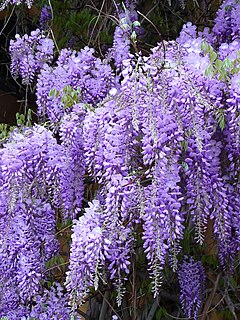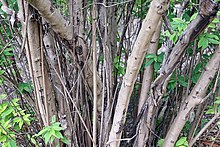
Wisteria is a genus of flowering plants in the legume family, Fabaceae (Leguminosae), that includes ten species of woody climbing bines that are native to China, Korea, Japan, and the Eastern United States. Some species are popular ornamental plants. An aquatic flowering plant with the common name wisteria or 'water wisteria' is in fact Hygrophila difformis, in the family Acanthaceae.

Myrciaria floribunda, commonly known as cambuizeiro, guavaberry or rumberry, is a species of plant in the family Myrtaceae. It can be found across south and central america in dry or moist coastal woodlands, up to 300 metres above sea level. The guavaberry, which should not be confused with the guava, is a close relative of camu camu.

Dasiphora fruticosa is a species of hardy deciduous flowering shrub in the family Rosaceae, native to the cool temperate and subarctic regions of the northern hemisphere, often growing at high altitudes in mountains. Dasiphora fruticosa is a disputed name, and the plant is still widely referenced in the horticultural literature under its synonym Potentilla fruticosa. Common names include shrubby cinquefoil, golden hardhack, bush cinquefoil, shrubby five-finger, and widdy.

Plumeria is a genus of flowering plants in the family Apocynaceae. Most species are deciduous shrubs or small trees. The species variously are endemic to Mexico, Central America and the Caribbean, and as far south as Brazil and north as Florida, but are grown as cosmopolitan ornamentals in warm regions. Common names for plants in the genus vary widely according to region, variety, and whim, but frangipani or variations on that theme are the most common. Plumeria is also used as a common name, especially in horticultural circles.

Wisteria floribunda is a species of flowering plant in the family Fabaceae, native to Japan and Korea. Growing to 9 m (30 ft), it is a woody, deciduous twining climber. It was brought from Japan to the United States in the 1830s. Since then, it has become one of the most highly romanticized flowering garden plants. It is also a common subject for bonsai, along with Wisteria sinensis.

Nuytsia floribunda is a hemiparasitic tree found in Western Australia. The species is known locally as moodjar and, more recently, the Christmas tree or Western Australian Christmas tree, as the display of intensely bright flowers during the austral summer coincides with the Christmas season.

Alchorneopsis is a genus of flowering plants in the family Euphorbiaceae first described as a genus in 1865. It is native to Central America, the Greater Antilles, and northern South America.
- Alchorneopsis floribunda(Benth.) Müll.Arg. - Costa Rica, Honduras, Panama, Puerto Rico, Dominican Republic, 3 Guianas, Colombia, Venezuela, Ecuador, Peru, NW Brazil
- Alchorneopsis portoricensisUrb. - Puerto Rico

Garuga is a genus of shrubs and trees in the family Burseraceae. Members are found in Asia and America.

A parasitic plant is a plant that derives some or all of its nutritional requirement from another living plant. They make up about 1% of angiosperms and are found in almost every biome. All parasitic plants have modified roots, called haustoria, which penetrate the host plant, connecting them to the conductive system – either the xylem, the phloem, or both. For example, plants like Striga or Rhinanthus connect only to the xylem, via xylem bridges (xylem-feeding). Alternately, plants like Cuscuta and Orobanche connect only to the phloem of the host (phloem-feeding). This provides them with the ability to extract water and nutrients from the host. Parasitic plants are classified depending as to the location where the parasitic plant latches onto the host and the amount of nutrients it requires. Some parasitic plants are able to locate their host plants by detecting chemicals in the air or soil given off by host shoots or roots, respectively. About 4,500 species of parasitic plant in approximately 20 families of flowering plants are known.

Diosgenin, a phytosteroid sapogenin, is the product of hydrolysis by acids, strong bases, or enzymes of saponins, extracted from the tubers of Dioscorea wild yam, such as the Kokoro. The sugar-free (aglycone) product of such hydrolysis, diosgenin is used for the commercial synthesis of cortisone, pregnenolone, progesterone, and other steroid products.
Helipterum is a genus of flowering plants in the sunflower family.

Malus floribunda, common name Japanese flowering crabapple, Japanese crab, purple chokeberry, or showy crabapple, originates from Japan and East Asia. It may be a wild species, or a hybrid of M. sieboldii × M. baccata.

Rosa 'Belmonte' is a light pink floribunda rose, created by Harkness Roses of Hitchin, Hertfordshire and introduced in Great Britain in 2007.

Lagerstroemia floribunda, also known as Thai crape myrtle and kedah bungor, is a species of flowering plant in the family Lythraceae. It is native of the tropical region of Southeast Asia.
Alchornea floribunda is a plant native to tropical Africa. The plant is locally known as Niando.

Banksia sessilis var. cordata is a variety of Banksia sessilis, with unusually large leaves and flower heads. It is a rare variety that is restricted to the extreme south-west corner of Western Australia.

Angophora floribunda, commonly known as the rough-barked apple, is a common woodland and forest tree of the family Myrtaceae native to Eastern Australia. Reaching 30 m (100 ft) high, it is a large tree with fibrous bark and cream-white flowers that appear over the Austral summer. It grows on alluvial soils on floodplains and along watercourses. Much of the land it grew on has been cleared for agriculture.

Embelia is a genus of climbing shrubs once placed in the family Myrsinaceae, which is now included in the Primulaceae. There are about 130 species which occur in tropical and subtropical areas across a wide range including Africa and Madagascar and from eastern Asia to the Pacific Islands as well as Australia including:
Sam McGredy refers to four generations of Northern Irish rose hybridizers. Sam McGredy I founded the family nursery in 1880. Sam McGredy II focused the nursery on roses in 1895. Sam McGredy III took over in 1926, and was the first to name roses after family members. Sam McGredy IV moved operations to New Zealand in 1974 to escape IRA death threat during The Troubles, and focused on Floribundas, Hybrid Teas and Grandifloras, including 'Paddy Stephens', 'New Zealand', and 'Kathryn McGredy'; and the hand-painted roses such as 'Regensberg'.

Holarrhena floribunda, commonly known as the false rubber tree, conessi bark or kurchi bark, is a plant in the family Apocynaceae.

















